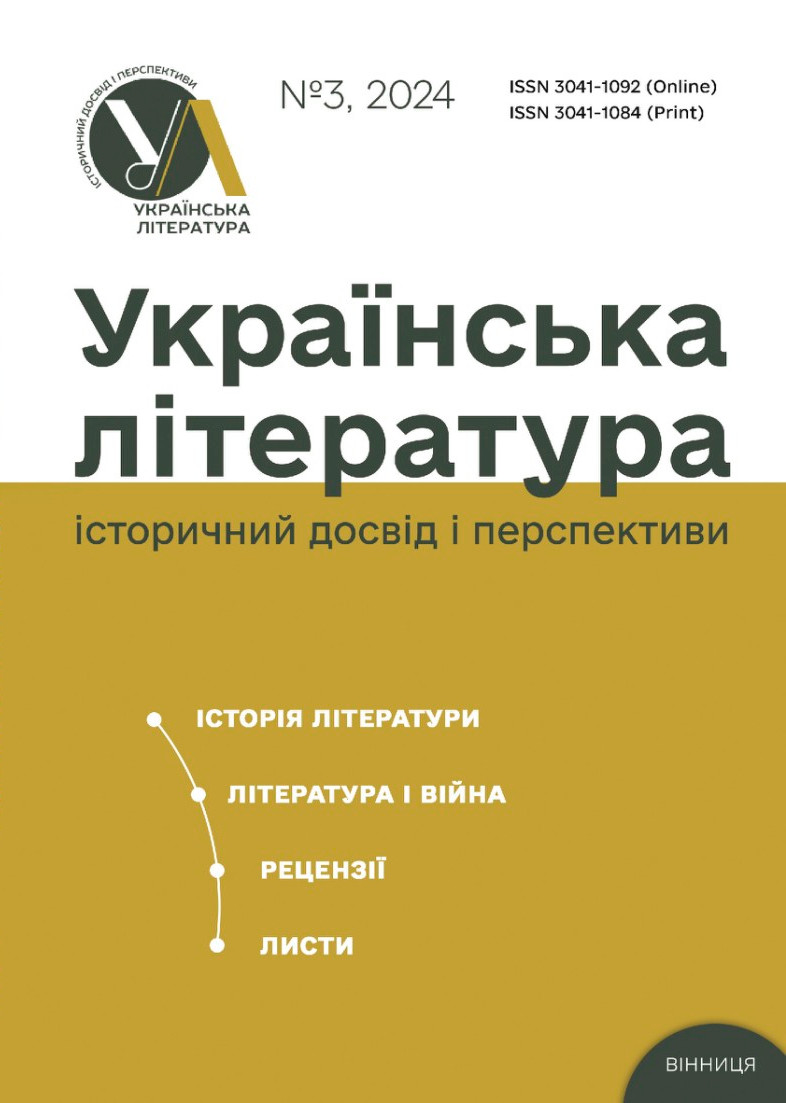Ukrainian intermedial resistance іn the military world
https://doi.org/10.31652/3041-1084-2024-3-08Published 2024-08-25
Keywords
- embaterium, intermediate practice, resistance, military world, poetry, song
Copyright (c) 2024 Юрій Ковалів

This work is licensed under a Creative Commons Attribution 4.0 International License.
How to Cite
Abstract
This article explores the historical persistence and motivation behind the intermedial practice of transforming verbal texts into musical ones, particularly focusing on Ukrainian embaterias and songs inspired by the russia-ukraine war, rich in motives from the heroics of the rank to the lyrical and tragic experiences of the resistance personality. It examines the dynamic synthesis of poetic and musical texts, tracing back to the practices of poets, composers, and singers from the Legion of the Ukrainian Sich Riflemen (Ukrainski Sichovi striltsi, USS). Drawing on the experience of Cossack and Opryshky songs, folklore, and early modernism, these artists created a unique repertoire that documents the artistic and freedom-loving nature of Ukrainians, tested by the harsh realities of war. Their works, reflecting the soul of the people, have become an integral part of Ukrainian folk songs.
Similarly, poets’ works of Ukrainian Insurgent Army (Ukrainska Povstanska Armiia, UPA) during and after World War II, set to music, provided an adequate response to the brutal realities of their time. This tradition has been preserved and gained new significance during the Russia-Ukraine war, declared by the Moscow State Duma of Ukraine on March 1, 2014, full-scale after February 24, 2022. Among the poets whose words have been set to music are graduates of the Taras Shevchenko National University of Kyiv, participants in military operations within the Ukrainian Armed Forces (such as Dmytro Luniaka) and the territorial defense (Ihor Astapenko). Academician Rostyslav Radyshevskyi has also actively contributed to these embaterias. Many songs are performed by serviceman Taras Kompanichenko. These texts, resembling pieces of a puzzle, will eventually form a coherent picture of intermedial creativity during the war, viewed through the historical dynamics of the genre.
Downloads
References
- Доценко О. Невідома сторінка з легенди про Українських Січових Стрільців. Календар Червоної Калини за 1924 р. Львів,1933. С. 46.
- Іваницький А. І. Український музичний фольклор. Інститут мистецтвознавства, фольклористики та етнології ім. М. Т. Рильського НАН України. 3-є вид. доп. Вінниця: Нова книга, 2004. 320 c.
- Качкан В., Качкан О. Нев’януча галузка калини: (Українські літератори, вчені, громадські діячі в діаспорі). Київ, 2011. 267 с.
- Кузьменко О. М. Стрілецькі пісні (аспекти фольклоризму, фольклоризації і фольклорності): автореф. … канд. філолог. наук. зі спец. 10.01.07 — Фольклористика. Львів, 2000. 19 с. DOI: https://doi.org/10.1590/S0104-14282000000100003
- Кузьменко О. Стрілецька пісенність: фольклоризм, фольклоризація, фольклорність. Львів: Інститут народознавства НАН України, 2009. 296 с.
- Купчинський Р. Невиспівані пісні. Нью-Йорк: Видавництво «Пластова Ватага «Бурлаки», 1983. 124 с.
- Роздольська І. В. Українська поезії резистансу 40-50 років: генетичний контекст і естетична природа: дисерт … канд. філолог. наук зі спец. 10.01.01 — Українська література. Львів, 2000. 232 с.
- Шумада Н. С. Сучасна пісенність слов’янських народів. Київ: Наук. думка, 1981. 359 с.





